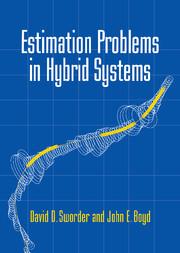Book contents
- Frontmatter
- Contents
- List of Illustrations
- Preface
- 1 Hybrid Estimation
- 2 The Polymorphic Estimator
- 3 Situation Assessment
- 4 Image-Enhanced Target Tracking
- 5 Hybrid Plants with Base-State Discontinuities
- 6 Mode-Dependent Observations
- 7 Control of Hybrid Systems
- 8 Target Recognition and Prediction
- 9 Hybrid Estimation Using Measure Changes
- Appendix 1 PME Derivation Details
- Appendix 2 COM Derivation Details
- Bibliography
- Index
- Glossary
2 - The Polymorphic Estimator
Published online by Cambridge University Press: 17 August 2009
- Frontmatter
- Contents
- List of Illustrations
- Preface
- 1 Hybrid Estimation
- 2 The Polymorphic Estimator
- 3 Situation Assessment
- 4 Image-Enhanced Target Tracking
- 5 Hybrid Plants with Base-State Discontinuities
- 6 Mode-Dependent Observations
- 7 Control of Hybrid Systems
- 8 Target Recognition and Prediction
- 9 Hybrid Estimation Using Measure Changes
- Appendix 1 PME Derivation Details
- Appendix 2 COM Derivation Details
- Bibliography
- Index
- Glossary
Summary
Introduction
At its basic level, an estimation algorithm is a causal mapping from a spatiotemporal observation (the measurement) to an approximation of a primary process (the signal or state, depending on the context). Estimators have become increasingly sophisticated as more versatile online processors have become available. If the state process has a suitable structure, improved estimation and prediction is achieved through model-based synthesis procedures. These approaches, as their name suggests, use a comprehensive analytical model to delineate both the state dynamics and the precise relationship between the state and its measurement. Using this model as an intermediary, a problem in optimal inference is posed. The solution to this optimization problem is then said to be the best estimation algorithm in the application. Through the model, the estimator is tuned to subtle patterns in the measurement, thus enabling good performance to be achieved in the presence of significant measurement ambiguity. Of course, the model is only an abridgement of reality, and to the degree that the model fails to adequately portray the salient features of the actual state processes, there is justifiable concern that the algorithm may be tuned improperly and may see things in the observation that are not actually there.
Perhaps the most widely studied model-based algorithm is the Kalman filter and its lineal variants. As described in Chapter 1, the dynamic features of the plant are represented by a base-state process {xt}.
- Type
- Chapter
- Information
- Estimation Problems in Hybrid Systems , pp. 41 - 55Publisher: Cambridge University PressPrint publication year: 1999



